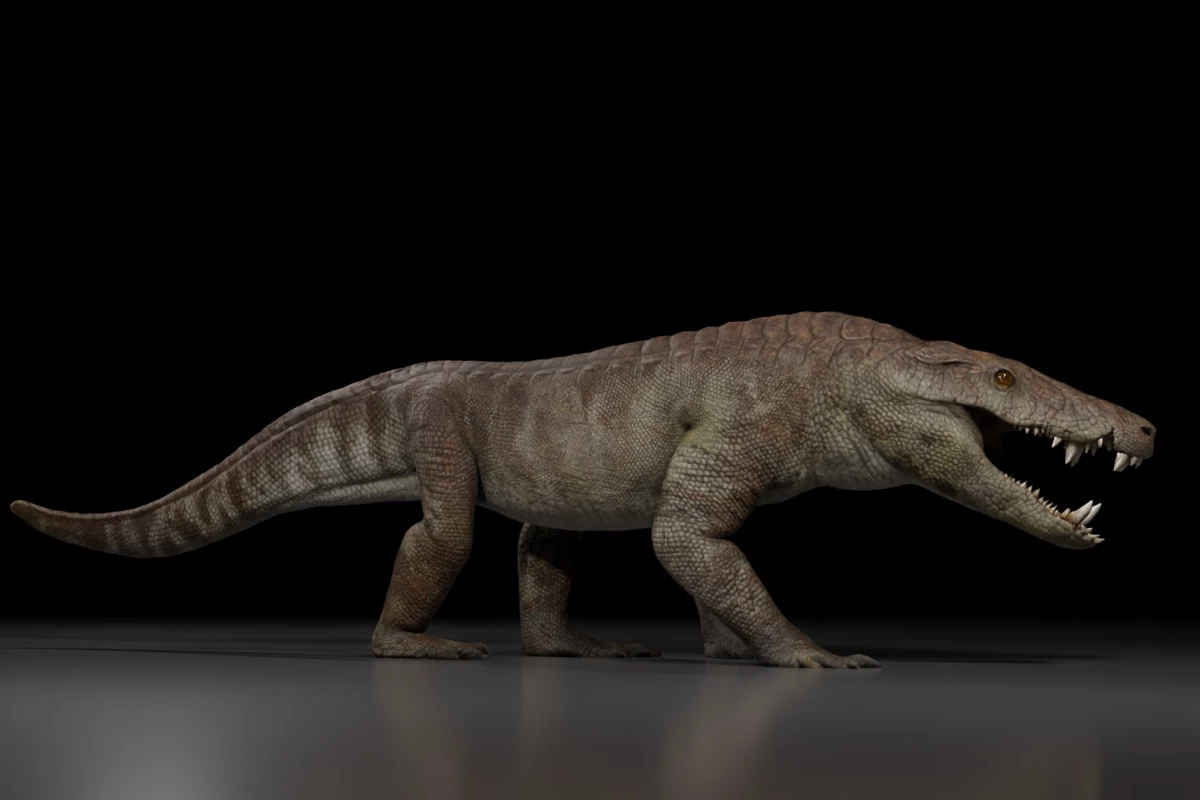Science
Ancient Crocodile Relative Revealed as Apex Predator of Dinosaurs

A recently discovered skeleton of a giant meat-eating crocodile relative has provided significant insights into the physiology and behavior of this ancient predator, known as Kostensuchus atrox. Unearthed near El Calafate, Argentina, this remarkably intact specimen dates back approximately 70 million years, during the late Cretaceous period. The findings suggest that this creature was a formidable land predator, preying on medium-sized dinosaurs among other species.
An international team of paleontologists, spearheaded by researchers from the Museo Argentino de Ciencias Naturales (MACN), has described Kostensuchus atrox as an entirely new species, as well as a novel genus. This discovery is particularly significant as it sheds light on the evolutionary tree of crocodyliforms, a group closely related to modern crocodiles. Unlike many previous specimens that were described from fragmentary remains, the Kostensuchus skeleton includes an almost complete skull and jaws, offering a clearer understanding of its anatomy and lifestyle.
Insights into Anatomy and Behavior
Measuring about 3.5 meters (11.5 feet) in length and weighing around 250 kilograms (551 pounds), K. atrox exhibited distinct features that mark it as a “hypercarnivore.” Its short, deep skull supported powerful jaw muscles, while blade-like, serrated teeth were designed for slicing flesh rather than gripping it. These adaptations indicate that this predator likely hunted actively, contrasting with the ambush strategies employed by modern crocodiles.
The name Kostensuchus reflects both regional heritage and ancient mythology. “Kosten” derives from the Aonikenk (Tehuelche) term for the strong Patagonian wind, while “suchus” is linked to Souchos, the Greek name for the crocodile-headed Egyptian god Sebek. The term “atrox,” meaning “harsh” in Greek, further emphasizes the predator’s formidable nature.
Researchers noted that Kostensuchus represents a previously poorly understood clade of crocodyliforms known as peirosaurids, which thrived exclusively during the Cretaceous period across regions of Gondwana, including South America, Africa, and Madagascar. Most known peirosaurids have been identified from incomplete remains, making this specimen a critical addition to the fossil record.
Ecological Context of the Late Cretaceous
The discovery of Kostensuchus atrox helps to enrich the understanding of the ecosystems in Patagonia during the late Cretaceous. Its remains were found within the Maastrichtian Chorrillo Formation, alongside fossils of medium-sized herbivorous and carnivorous dinosaurs. This suggests that crocodyliforms like K. atrox not only coexisted with dinosaurs but also likely competed for prey at the top of the food chain.
“Although broad-snouted peirosaurids are potentially closely related to each other, so far these taxa have been rarely included in phylogenetic analyses, likely due to the incompleteness of their remains,” the researchers explained. The well-preserved skull of Kostensuchus allows for a better understanding of its morphology, enabling comparisons with other crocodyliforms and providing new insights into their evolutionary relationships.
Crocodyliforms once occupied a diverse range of ecological niches, from specialized hunters like K. atrox to fish-eaters and plant-foragers. The extinction of peirosaurids, alongside non-avian dinosaurs, approximately 66 million years ago marked the end of a diverse lineage. Today’s crocodiles, alligators, and gharials are the last remnants of this once-varied group.
The findings from this study, published in the journal PLOS One, not only serve as a benchmark for future research but also illuminate the diversification of ancient crocs into giant, meat-eating specialists in the lead-up to their sudden extinction. The insights gained from Kostensuchus atrox could reshape our understanding of predatory dynamics in ancient ecosystems and highlight the complex relationships that existed long before the age of mammals.
-

 Technology4 months ago
Technology4 months agoDiscover the Top 10 Calorie Counting Apps of 2025
-

 Health2 months ago
Health2 months agoBella Hadid Shares Health Update After Treatment for Lyme Disease
-

 Health3 months ago
Health3 months agoErin Bates Shares Recovery Update Following Sepsis Complications
-

 Technology3 weeks ago
Technology3 weeks agoDiscover 2025’s Top GPUs for Exceptional 4K Gaming Performance
-

 Technology2 months ago
Technology2 months agoElectric Moto Influencer Surronster Arrested in Tijuana
-

 Technology4 months ago
Technology4 months agoDiscover How to Reverse Image Search Using ChatGPT Effortlessly
-

 Technology4 months ago
Technology4 months agoMeta Initiates $60B AI Data Center Expansion, Starting in Ohio
-

 Technology4 months ago
Technology4 months agoRecovering a Suspended TikTok Account: A Step-by-Step Guide
-

 Health4 months ago
Health4 months agoTested: Rab Firewall Mountain Jacket Survives Harsh Conditions
-

 Lifestyle4 months ago
Lifestyle4 months agoBelton Family Reunites After Daughter Survives Hill Country Floods
-

 Technology3 months ago
Technology3 months agoUncovering the Top Five Most Challenging Motorcycles to Ride
-

 Technology4 weeks ago
Technology4 weeks agoDiscover the Best Wireless Earbuds for Every Lifestyle













